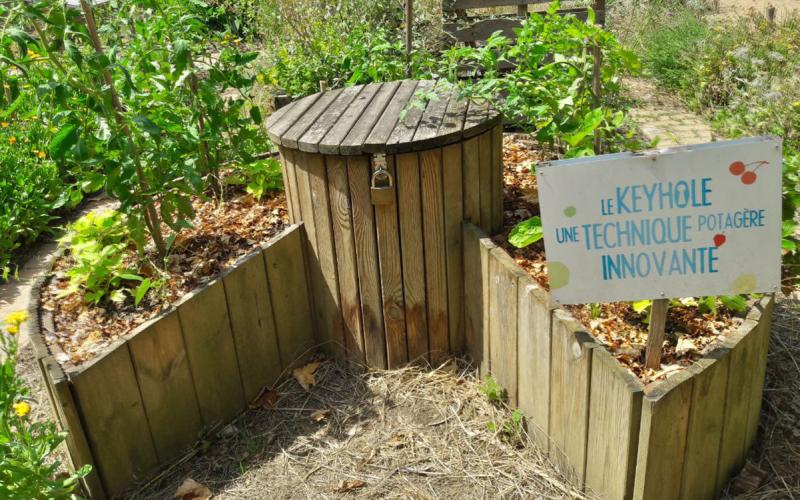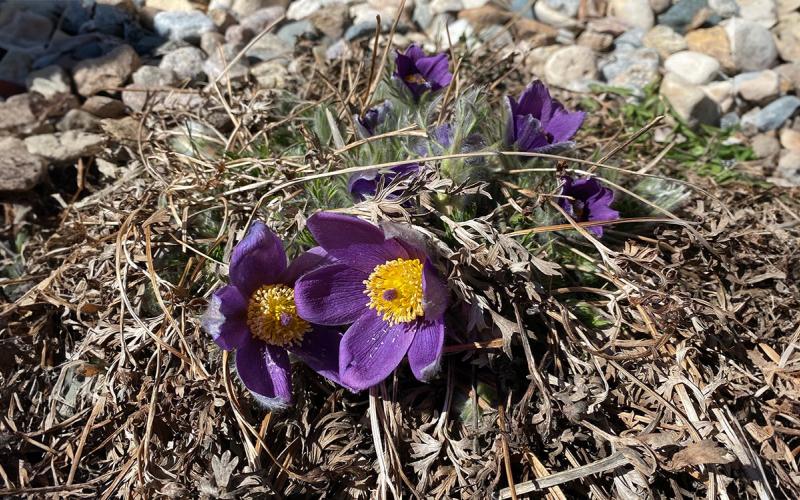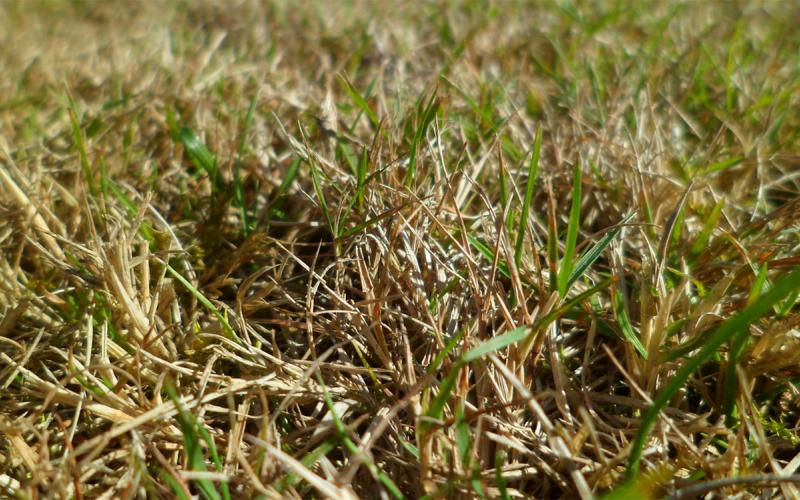Written by David Chalmers, former Professor & SDSU Extension Turfgrass Associate.
As of August 29th the city of Sioux Falls has moved from Stage 1 watering, which allowed every other day watering except between the hours of 12 noon and 5 PM, to Stage Two water restrictions; allowing only one day per week watering based upon the last number of the residence address.
The watering schedule is determined by the flow of the Big Sioux River as measured by the USGS Monitoring Station located near Dell Rapids, SD. River flow above 50 cubic feet per second allows for a “normal” or Stage 1 watering schedule of every other day watering based upon odd/even address. Stage 2 kicks in when the river flow drops below 50 cubic feet per second. Stage 3 would begin when the river flow drops below 20 cubic feet per second and it would prohibit all landscape watering. Let’s hope we don’t reach that level!
The City of Sioux Falls provides a good example of having a measured conservation strategy in place for times of drought and concerns about water resources being sufficient for both citizens and commerce. To learn about how the City of Sioux Falls implements staged water restrictions on water use outside of the home, visit their website on Lawn Watering Schedules.
Other South Dakota Communities may initiate their own restrictions based upon projected water supplies and the prolonged drought conditions. Regardless of whether water restrictions are in place in your community, home consumers and the landscape industry can certainly benefit if they understand both the agronomic and economic benefits of water conservation.
That being said, now is a very good time to review the principles of lawn irrigation “best management practices” to conserve water as best we can.
When is the best time to water turfgrass?
Lawn irrigation is best practiced when there is the greatest chance of getting the water applied uniformly. Irrigation, especially when conservation measures are enacted in drought is all about getting water into the soil.
-
Early morning is the best time to irrigate due to better irrigation distribution from reduced wind and less water evaporation before water infiltrates into the soil (lower wind, lower temperatures and less sunlight).
-
The normal concerns about not watering during evening hours (to reduce the associated prolonged leaf wetness period as an IPM way to reduce the likelihood of turf diseases) is less a concern in periods of drought, low humidity and infrequent irrigation.
Evaluate how efficiently water is applied with irrigation.
Irrigation methods range from an automatic sprinkler system with a number of zones or a portable hose and sprinkler that is moved around the property in a timely manner. Both can do a good job and both can do a poor job! When asked how much they water, the reply from both home consumers and professionals is often “some number of minutes”! This is only meaningful if the irrigation run time is measured back to the amount of time it will need to run tom apply a known amount of water (in inches). The other part of efficient irrigation is having a irrigation method in good repair to water as uniformly as possible.
-
Have your irrigation system checked out for problems such as broken heads, leaking valves, heads not popping up properly, overspray onto pavement, etc. All these problems will result in non-uniform watering.
-
The very best automatic in-ground irrigation systems are only 80% uniform in water distribution. Many systems never come close to 80% and are only 50 to 60% uniform. This means that while it may look uniform in coverage when operating, there will be some wetter spots and some drier spots. These will likely become more obvious when only watering once per week!
-
Irrigation cycling, where the system or hose and sprinkler run times are less but repeated a second or third time, is useful in matching water application with soil water infiltration rates.
-
The Stage 2 once per week watering schedule will likely result in some loss of green color or irregular lawn appearance...browning off mixed with green. This will lessen when our day/night temperatures cool off since the water requirement per week will be reduced.
-
With large properties, a large number of zones will be difficult to irrigate in just one day. Applying more water than the soil can absorb will cause runoff and wasted water. This may require prioritizing some areas over others to reduce the irrigated area.
Applying the right amount of water in inches!
Rain gauges measure rainfall in inches and are highly recommended. Time watered, in minutes, rarely links back to gallons watered and inches applied. Therein lies the challenge to watering with “good knowledge and practice”; to understand how to apply water in measured amounts (inches), while taking into account any contribution from measurable rainfall (inches). The great benefit in doing this lies in being able to relate inches applied to gallons applied, which will be reflected on the monthly water bill. Efficient and “water wise practices” can help conserve water and help the monthly summer budget.
-
Sprinkler output is measured by running the sprinklers long enough to catch a measurable amount of water. “Catch cans”, are flat sided and flat bottomed containers (coffee cups, old food cans are useful, used tuna-type cans work well) and then measure water depth in inches over the time collected. It is best to “catch can” each zone watered with an automatic system. Hose/sprinkler irrigation need not be repeated if the equipment is the same.
-
Use 5 or more “catch cans” for each zone watered. After collecting water for say 15 minutes. For this example let’s say the 5 cans end up with water depths of 0.3, 0.25, 0.25, 0.2 and 0.25 inches respectively. The average depth (this by the way would be very good uniformity) over the five cans is 0.25 inches in 15 minutes. So it would take 1 hour to apply 1.0 inches for that zone. This is how one knows how long the system needs to run to apply 1-inch of water. Less water can be applied during spring or fall by adjusting the time based upon need.
How much water is enough?
-
Recommendations as to how much water to apply in the absence of recent rainfall (like the current drought) is expressed as a crop water deficit (in this case turfgrass) and is stated in inches. It is based upon local weather station evapotranspiration measurements and what level of drought and heat stress are deemed as acceptable.
-
A common mid-summer recommendation for Kentucky bluegrass and other cool season grass lawns is to apply 1-inch of water per week. Less water can be applied under cooler and less stressful conditions of spring and fall. This level of irrigation is meant to keep the grass green without undue stress.
-
An exception to this is for grass sports turf (baseball, football and soccer) during summer. They will require more than 1-inch of water per week to have the grass continue to recover from the traffic and wear of each sport.
-
If less than 1-inch of water is applied per week the lawn will begin to show stress (browning and thinning) but it will be able to recover with rainfall or the easing of water restrictions. This is certainly an option where a bit of brown mixed with green is acceptable and the grass should be able to recover with fall-like temperatures and then applying irrigation to recover the lawn quality before winter.
-
A single irrigation of 1-inch of water, applied once per week under the Stage 2 schedule, is a real challenge with the time required to run the system and having the soil being able to absorb all of that water! Yet, the common recommendation for turf is to water deeply and infrequently and once per week may be able to provide good results if the soil takes in the applied irrigation.
Relating Lawn Irrigation Back To Your Water Bill
To finish off this article I thought it would be instructional to use the Sioux Falls Residential Single Family charges for water use to demonstrate the costs associated with using municipal water supplies to water various lawn sizes at the summer recommended 1-inch per week rate.
-
Water provided to consumers by their municipality are charged for water use by gallons used. There may also be a sewer charge for water used outside the home.
-
One-inch of irrigation equals 0.62 gallon of water applied per square foot. This converts to 620 gallons of water for each 1,000 sq ft of irrigated lawn area.
Water usage in Sioux Falls is calculated in units of 100 cubic feet (CCF) of water, which is equal to 748 gallons. The charges for “Residential Single-Family” use are on a scale that has greater amounts of water use being charged more. This is a common incentive to conserve water and use less water outside the home. The rates are:
0 to 7 CCF = $3.33 per CCF
8 to 50 CCF = $3.56 per CCF
51 to 150 CCF = $6.64 per CCF
over 150 CCF = $9.97 per CCF
Using this example I have developed the following table based upon increasing lawn sizes irrigated at 1-inch per week and then basing costs of irrigation off of the associated Sioux Falls water charges.
| Lawn Size (Square Feet) | Weekly Summer Water Use (gallons per 1-inch) | Monthly Water Use (gallons) | Monthly CCF* used | Monthly Water Cost (Residential single-family) |
|---|---|---|---|---|
|
1,000 |
620 |
2,480 | 3 | $11.04 |
| 2,500 | 1,550 | 6,200 | 8 | $26.87 |
| 5,000 | 3,100 | 12,400 | 17 | $58.91 |
| 7,500 | 4,650 | 18,600 | 25 | $87.39 |
| 10,000 | 6,200 | 24,800 | 33 | $115.87 |
| 43,560 (1 acre) |
27,007 | 108,029 | 144 |
$800.55 |
| *CCF = units of 100 cubic feet (CCF) of water, which is equal to 748 gallons | ||||
Simulated approximate water use and charges for various size cool season grass lawns in Sioux Falls South Dakota, based upon a maximum summer water use of 1-inch per week during drought conditions. The table assumes no contribution from rainfall and only addresses the amount of water used outside the home.
Summary
This article has tried to be timely in helping home consumers and landscape professionals understand some of the challenges in lawn irrigation during a drought. This example uses the measured response of the City of Sioux Falls moving to their Stage 2 Watering Schedule on August 29th. Yet it is an appropriate lesson for all South Dakota in this year of drought. Fall will soon be upon us and the cooler temperatures will greatly lessen the weekly water needed for turf used for lawns, recreation and sport. Hopefully some good rainfall will arrive as well!


